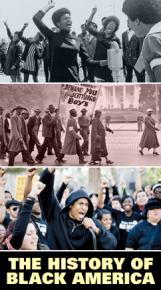The fallacy of “reverse racism”
answers a charge continually made against Black freedom struggle.
THE TERM "reverse racism" still shows up on occasion in the media. Let the press encounter a crime in which the victim is white and the perpetrator is African American, and that becomes part of the explanation. The idea of "Black racism" against whites gets thrown out even more consistently against organizations of all or primarily African Americans who challenge racism.
Such ideas must be rejected out of hand. Racism is not simply animosity based on skin color or other physical characteristics, but a systematic, special oppression, which employers use to keep the working class divided and to forestall any challenge to their rule.
The material basis for racism in the U.S. is a Black unemployment rate double that of whites, an inflated poverty rate for Black families and individuals and an ongoing wage differential between Black and white workers.
Racial oppression goes far beyond the labor market, too. More than half a century after the U.S. Supreme Court ruled that "separate but equal" public facilities for Blacks and whites were inherently unequal, many public schools in U.S. cities remain segregated--in fact, they have become more segregated in recent years, not less.
In every U.S. city, there are wealthy and mostly white neighborhoods where young Blacks, if they venture into them, face certain harassment from police. The claim that whites face similar treatment in all-Black neighborhoods from residents is false.
Blacks cannot be "racists." They are not in a position to oppress anyone--certainly not the majority white population of the U.S.
BUT THE charge of "Black racism" has always been used to discredit militants, especially Black nationalists. The two most important Black nationalists of the 20th century, Marcus Garvey and Malcolm X, were both denounced for their message of racial pride and their calls for Blacks to arm themselves against racist attacks.
In the early 1960s, the question of "retaliatory violence" was raised by Blacks who felt that the civil rights movement's "nonviolent direct action" strategy was ineffective and even dangerous in the face of violent repression by Southern racists and their police allies. Robert Williams, of Monroe, N.C., urged members of his NAACP branch to take up rifle training, an idea that gained support following the bombing of Black children in Birmingham in 1963 and the murder of civil rights activists in Mississippi in 1964.
One of Socialist Worker's earliest features was a monthly series on the history of the African American struggle in the U.S., from slavery to the present day.The History of Black America
Not surprisingly, those who heeded Malcolm X's call for self-defense "by any means necessary" were criticized by liberals and conservatives alike as "Black racists." This, of course, diverted attention from the segregationists, who were the real source of violence.
The question of retaliatory violence was also debated among Northern activists. Louis Smith, field secretary of the Congress of Racial Equality (CORE), said after the 1965 Black rebellion in Los Angeles:
I find it amusing that those who are quickest to condemn the revolt of the people in Watts, who were only asking to share in the American dream, are the people who worship our revolt against England. Watts was saying to white America that [Blacks refused to] march to the gas chambers.
The charge of "Black racism" was also leveled at those who wanted all-Black leadership in interracial organizations like CORE or the Student Nonviolent Coordinating Committee.
There were many reasons for the resurgence of Black nationalism in the 1960s. Among the most important were the escalation in racist violence, deep pessimism among Blacks about the potential for a united struggle with whites, and the sellouts by white liberals, who constantly tried to steer the Black movement into the Democratic Party. To many African Americans, an all-Black organization appeared to be the only way to wage a consistent struggle against racism.
The nationalist sentiment, characterized by the slogan "Black Power," met with shrill denunciation from white liberals who supposedly opposed racism. For example, Black autoworkers in Detroit's Dodge Revolutionary Union Movement (DRUM) during the late 1960s were labeled as "Black fascists" by the same United Auto Workers Union bureaucrats who had participated in civil rights marches.
Even more severe was the criticism of the Black Panther Party for Self-Defense, which gained national attention for its armed confrontation with the brutal racist cops of Oakland, California.
Liberals--both white and Black--invariably respond to Black militancy with an appeal for "calm and racial unity." Often enough, this means demobilizing protests and a highly publicized meeting of interracial "leaders," who do not even address the roots of racism, much less challenge them.
By contrast, socialists call for unity in the working class on Black workers' terms. This will require winning white workers to a recognition of Blacks' special oppression and an understanding that all workers have a material interest in Black liberation. In practice, this means socialists must defend the right of Blacks to self-determination, and even separatist organization when it is called for.
The argument about the "racism" of Blacks is, as it always has been, nothing but a cover for the real source of racism, cultivated by the capitalist system.
As Leon Trotsky said in the 1930s, Black and white working class unity will be built by those who fight an "uncompromising merciless struggle, not against the supposed national prepossessions of Blacks, but against the colonial prejudices of the white worker, and make no concessions to them whatever."
First published in the January 1987 edition of Socialist Worker.



